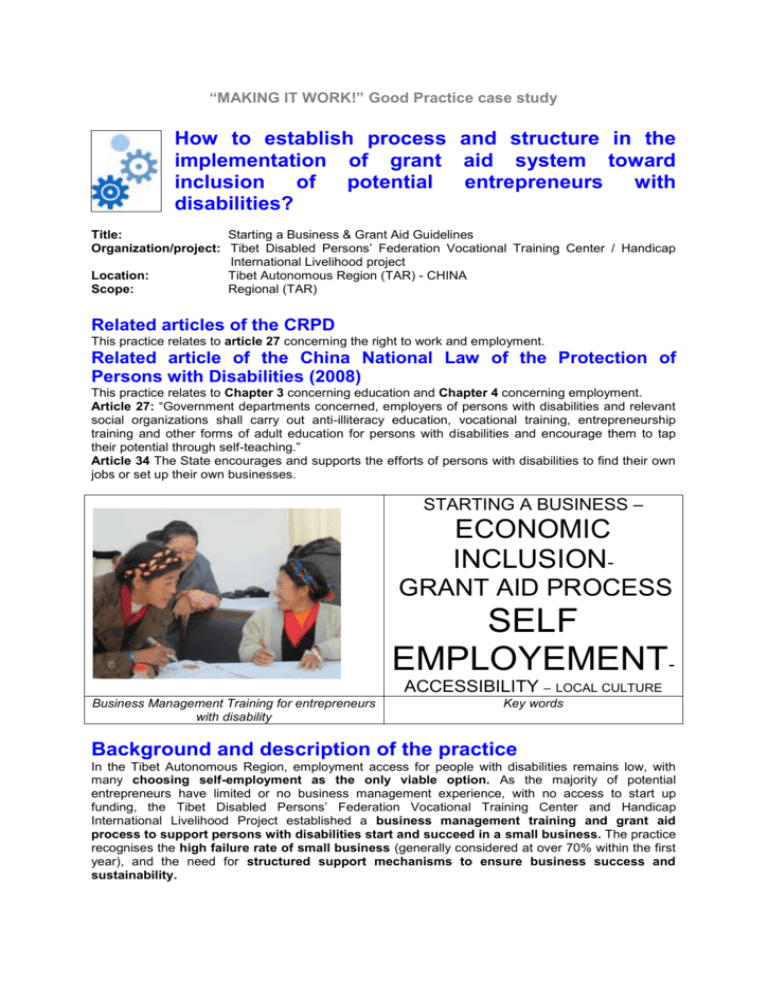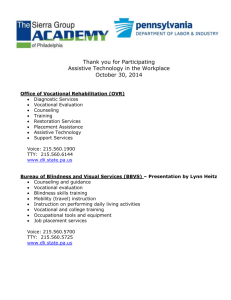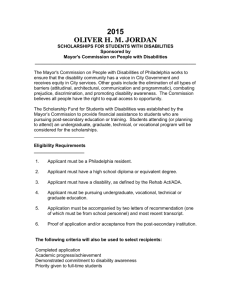the file
advertisement

“MAKING IT WORK!” Good Practice case study How to establish process and structure in the implementation of grant aid system toward inclusion of potential entrepreneurs with disabilities? Title: Starting a Business & Grant Aid Guidelines Organization/project: Tibet Disabled Persons’ Federation Vocational Training Center / Handicap International Livelihood project Location: Tibet Autonomous Region (TAR) - CHINA Scope: Regional (TAR) Related articles of the CRPD This practice relates to article 27 concerning the right to work and employment. Related article of the China National Law of the Protection of Persons with Disabilities (2008) This practice relates to Chapter 3 concerning education and Chapter 4 concerning employment. Article 27: “Government departments concerned, employers of persons with disabilities and relevant social organizations shall carry out anti-illiteracy education, vocational training, entrepreneurship training and other forms of adult education for persons with disabilities and encourage them to tap their potential through self-teaching.” Article 34 The State encourages and supports the efforts of persons with disabilities to find their own jobs or set up their own businesses. STARTING A BUSINESS – ECONOMIC INCLUSIONGRANT AID PROCESS SELF EMPLOYEMENTACCESSIBILITY – LOCAL CULTURE Business Management Training for entrepreneurs with disability Key words Background and description of the practice In the Tibet Autonomous Region, employment access for people with disabilities remains low, with many choosing self-employment as the only viable option. As the majority of potential entrepreneurs have limited or no business management experience, with no access to start up funding, the Tibet Disabled Persons’ Federation Vocational Training Center and Handicap International Livelihood Project established a business management training and grant aid process to support persons with disabilities start and succeed in a small business. The practice recognises the high failure rate of small business (generally considered at over 70% within the first year), and the need for structured support mechanisms to ensure business success and sustainability. Process involved 1. Information dissemination: Use of radio, TV and newspaper articles to reach remote areas. Relevant bodies; Disabled Persons Organisations, Civil Affairs Bureau, grassroots organisations and community workers have disseminated the information on grant aid. 2. Selection criteria: Specific selection criteria have been implemented to mitigate business failure. 3. Applicant interview & initial assessment: The interview and assessment aimed to gauge the individual’s knowledge, skills and motivation to succeed in business, also assessing the levels of support available and required by the applicant. 4. Draft business plan: The applicant was requested to complete a draft plan, with a brief outline of the proposed business. The plan may have been completed with a staff member/trainer/ family/ friend if the applicant has literacy issues. 5. Skills testing: Where possible, the applicant was requested to participate in skills testing (sewing, furniture paining, and massage) to ensure s/he has the level of required skills. If the applicant was lacking a high percentage of required skills, s/he was referred for further training. 6. Specific skills training: On conditional grant aid approval, the applicant participated in specific skills training (1-3 weeks), related to the chosen business in the Vocational Training Center/enterprise company, to ensure skills level meets market requirements. The applicant attended business management training, to ensure an awareness of the realities of starting and operating a business. 7. Business start up & monitoring: Following training, the applicant submitted a detailed business plan, to include start up costs. Contracts was drawn up and agreed, including conditions of the grant aid, and participant responsibility for equipment and financial aid. 8. 6 month follow up and evaluation report. Resources required Support organisations: 2 staff from Handicap International Tibet Disabled Persons’ Federation management support County Civil Affairs Tibet Disabled Persons’ Vocational Training Base (2 staff from Training Department, 1 staff from Job Department) Funding : Starting a Business & Grant Aid Process was funded through the Tibet Disabled Persons’ Federation Vocational Training Center and Handicap International Livelihood Project. The factors that made this practice possible Cooperation, consultation and agreement between the project partners on the pilot process, to include follow up, evaluation and revision. Recognition by local partners that structures were required to establish good practice in the grant aid process. Ready availability of graduate potential entrepreneurs with technical skills base. Funding available through the Livelihood Project to provide start up grant aid. Resources e.g. training rooms, equipment, trainers available to support the process. Some of the difficulties encountered High support levels asked by some participants, some were reluctant to take personal responsibility. It is recommended that initial assessment, training, contracts must clearly indicate support limitations Time pressure on project staff to continuously help participants, as a result support limitations discussed with participants Ongoing funding is not available. Support from Civil Affairs has to be requested. The effects / impact of the practice The project was successful in establishing a grant aid, training and support model for persons with disabilities starting a business. Tibet Disabled Persons’ Federation Vocational Training Center will continue the grant aid process in 2012 & 2013, supporting a total of 50 participants with disabilities start a business over the three year project period. The practice is inclusive in a number of ways, the gender balance (8 male, 7 female) in the 2011 pilot, the inclusion and potential future economic empowerment of persons with disabilities by providing the opportunity to start a business and earn a living. Possible improvement For participants: Provide basic literacy and numeracy training. Further financial planning in business training. Business training to cover the differing urban and rural market needs. Ensure family members are fully involved and supportive. Participants must understand project support is limited, and take personal responsibility for the business. Inform participants on Social Protection policies. Recommendations for the replication of this practice Establish a ‘loan’ system, participants to repay the start up grant aid. Ensure a comprehensive vocational assessment for applicants is in place. Ensure participants understand time limits (e.g. the project will not provide ongoing support). Encourage participants to save money. Initial assessment to include physical ability (are applicants physically able for the work?). Develop Start On Business (SoB) trainer toolkit to meet low literacy needs. More information Yandrum, Handicap International Livelihood Project Manager hivtb@handicap-int.org.cn Brona O’Donnell, Handicap International Livelihood Adviser hi.vtbadv@handicap-int.org.cn Full project report: Collection of good practices for the inclusion of people with disabilities Criteria for the good practices: see page 8 (Part 1 of the report) Recommendations from the good practices: Part 3 of the report






